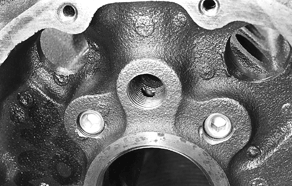In the plug in the passenger side passage, drill out the plug 0.030" (1/32") to spray on the chain. You can also drill the other two plugs to release trapped air, but it's not necessary.
You can tap the plug holes with a 1/4' pipe tap and use pipe plug, but use a shallow plug for the center hole so as to not to block the oil galley behind it.
Oil pump pickup should be held 3/8' to /1/2" off the bottom of the pan. When located correctly, weld the pickup in place.
REFERENCE
Block Plug Basics, Super Chevy
"Most small-blocks feature four 3/8-inch threaded holes (two per side) at the front of the block. The upper hole adjacent to the fuel pump passes into the crankcase area and if left open will allow oil to leak out from the block. Be certain to plug this hole only with a short 3/8-inch bolt (1/2-inch long). Because this hole aligns perfectly with the fuel pump’s pushrod, a longer bolt will contact and seize the pushrod during engine operation."
Grump's Performance Oil System Mods.
You can tap the plug holes with a 1/4' pipe tap and use pipe plug, but use a shallow plug for the center hole so as to not to block the oil galley behind it.
Oil pump pickup should be held 3/8' to /1/2" off the bottom of the pan. When located correctly, weld the pickup in place.
REFERENCE
Block Plug Basics, Super Chevy
"Most small-blocks feature four 3/8-inch threaded holes (two per side) at the front of the block. The upper hole adjacent to the fuel pump passes into the crankcase area and if left open will allow oil to leak out from the block. Be certain to plug this hole only with a short 3/8-inch bolt (1/2-inch long). Because this hole aligns perfectly with the fuel pump’s pushrod, a longer bolt will contact and seize the pushrod during engine operation."
Grump's Performance Oil System Mods.

Comments